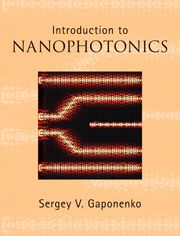Book contents
- Frontmatter
- Contents
- Preface
- Notations and acronyms
- 1 Introduction
- Part I Electrons and electromagnetic waves in nanostructures
- Part II Light–matter interaction in nanostructures
- 13 Light – matter interaction: introductory quantum electrodynamics
- 14 Density of states effects on optical processes in mesoscopic structures
- 15 Light–matter states beyond perturbational approach
- 16 Plasmonic enhancement of secondary radiation
- Author index
- Subject index
15 - Light–matter states beyond perturbational approach
from Part II - Light–matter interaction in nanostructures
Published online by Cambridge University Press: 05 June 2012
- Frontmatter
- Contents
- Preface
- Notations and acronyms
- 1 Introduction
- Part I Electrons and electromagnetic waves in nanostructures
- Part II Light–matter interaction in nanostructures
- 13 Light – matter interaction: introductory quantum electrodynamics
- 14 Density of states effects on optical processes in mesoscopic structures
- 15 Light–matter states beyond perturbational approach
- 16 Plasmonic enhancement of secondary radiation
- Author index
- Subject index
Summary
In nanostructures where confinement of a light wave is manifested, the conditions of strong light–matter interaction become feasible. In this case, the approach based on the environment-sensitive probability of quantum transitions is no longer applicable. Instead, joint states of light and matter should be considered and their time evolution explored. The content of the previous Chapters 13 and 14 can then be treated as a perturbative description of light–matter interactions with a limited range of applicability. In this chapter a few representative examples are given where joint light–matter states bring an unprecedented flavor of nanophotonic engineering to frozen excited states for quantum memory devices and single photon sources for quantum computing.
Cavity quantum electrodynamics in the strong coupling regime
The regime of strong coupling of a quantum system with an electromagnetic field can be performed in a cavity with very high Q-factor, where light can survive for a reasonable time until it either leaves the cavity or dies through being absorbed by cavity imperfections. In a simplified picture, a photon once emitted stays within the cavity so long that it is absorbed again by the emitter (an imaginary two-level system, an atom or a quantum dot). Thus spontaneous emission appears to become reversible. In a more accurate presentation, an “atom+field” state develops which evolves via oscillations between the state |E, 0〉 (“excited atom, depleted cavity”) to the state |G, 1〉 (“de-excited atom, a photon in the cavity”).
- Type
- Chapter
- Information
- Introduction to Nanophotonics , pp. 424 - 435Publisher: Cambridge University PressPrint publication year: 2010



